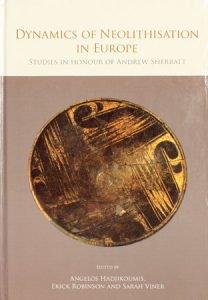BOOKS | 2011
M.S.F. Hood & Gerald Cadogan
London
2011
 From 1957 to 1961 the British School at Athens undertook an extensive programme of stratigraphical excavations at Knossos under Sinclair Hood, then Director of the School. This report publishes in detail the results of investigations into Early Minoan levels, which shed much new light on the era before the "Old Palace" was established.
From 1957 to 1961 the British School at Athens undertook an extensive programme of stratigraphical excavations at Knossos under Sinclair Hood, then Director of the School. This report publishes in detail the results of investigations into Early Minoan levels, which shed much new light on the era before the "Old Palace" was established.
Orgeolet, R.
L’Antiquité Classique
Orgeolet, R., 2011. Review of A.L. D’Agata & A. Van de Moortel (eds), Archaeologies of Cult. Essays on Ritual and Cult in Crete in Honor of Geraldine C. Gesell (Princeton 2009), L’Antiquité Classique.
Read the book review
Νένα Γαλανίδου
Anaskamma 5 (2011): 33-52.
This paper addresses the potential contribution of archaeological sites and finds from old excavations to the modern archaeological discourse and to improving modern urban life. The discussion is centred around Neolithic Katsambas, a Neolithic hamlet and its adjacent burial rockshelter, excavated by Stylianos Alexiou in the first half of the 1950’s.
Χρήστος Μπουλώτης
Anaskamma 5 (2011): 13-31.
An unfinished drop-shaped bead of rock crystal, found during the 2004 excavation season at the Bronze Age settlement of Koukonisi (Lemnos, Moudros gulf ) provides the opportunity to discuss, foremost, the concept and significance of unfinished artefacts as vehicles of particular “historical” information.
Orgeolet, R.
L’Antiquité Classique
Orgeolet, R., 2011. Review of K. Sarri, Orchomenos IV. Orchomenos in der mittleren Bronzezeit (Munich 2010), L’Antiquité Classique.
Read the book review
Edited by Angelos Hadjikoumis, Erick Robinson & Sarah Viner
Oxford/Oakville
 Dynamics of Neolithisation in Europe examines the development of early agriculture in Neolithic Europe, drawing on the work of the late Professor Andrew Sherratt. His untimely death coincided with an important period of research that moved beyond searching for singular causal mechanisms behind the ‘neolithisation’ of Europe in favour of developing a better understanding of the complex interrelationships of cultural, ecological, economic and social factors.
Dynamics of Neolithisation in Europe examines the development of early agriculture in Neolithic Europe, drawing on the work of the late Professor Andrew Sherratt. His untimely death coincided with an important period of research that moved beyond searching for singular causal mechanisms behind the ‘neolithisation’ of Europe in favour of developing a better understanding of the complex interrelationships of cultural, ecological, economic and social factors.
Yves Duhoux
Kadmos 49 (2011): 47-92.
Il n’existe qu’environ 150 vases (entiers ou, le plus souvent, fragmentaires) à étrier inscrits en linéaire B, alors que l’on a un nombre incalculable d’exemples anépigraphes de ce type de poterie.
Elisabeth Schofield (edited with contributions by Jack L. Davis & Carol Hershenson and architectural drawings by Whitney Powell-Cummer)
Darmstadt
 The book is a premature publication of Elizabeth Schofield, who died in 2005. It presents the Western Sector of the Ayia Irini site on Keos (Cyclades). Two features of the Late Bronze Age Western Sector are of particular importance for understanding the disposition of the settlement of Keos and the way it was reorganised in Periods VI (= LH I) and VII (= LH II).
The book is a premature publication of Elizabeth Schofield, who died in 2005. It presents the Western Sector of the Ayia Irini site on Keos (Cyclades). Two features of the Late Bronze Age Western Sector are of particular importance for understanding the disposition of the settlement of Keos and the way it was reorganised in Periods VI (= LH I) and VII (= LH II).
Kramer-Hajos, M.
Bryn Mawr Classical Review
Kramer-Hajos, M., 2011. Online review of J.M.A. Murphy, Prehistoric Crete: Regional and Diachronic Studies on Mortuary Systems (Philadelphia 2011), Bryn Mawr Classical Review 2011.12.39.
Read the book review
Weingarten, J.
Bryn Mawr Classical Review 2011.09.53
Weingarten, J., 2011. Online review of D.B. Counts & B. Arnold (eds), The Master of Animals in Old World Iconography (Budapest 2010), Bryn Mawr Classical Review 2011.09.53.
Read the book review
Orazio Monti
Kadmos 49 (2011): 39-45.
On a déjà remarqué que. dans l’inscription (gravée sur un pithos) PE Zb 3 a-ka-ra ki-ta-na-si-ja-se HOMO+ZA, le -se final et l’idéogramme AB 100/102 = HOMO, en ligature avec AB 17/za, ont été ajoutés après coup par une autre main; on a ici, donc, l’alternance *ki-ta-na-si-ja/ki-ta-na-si-ja-se.
Kennell, S.A.H.,
Bryn Mawr Classical Review
Kennell, S.A.H., 2011. Review of F. Kolb, Tatort ‘Troia’: Geschichte, Mythen, Politik (Paderborn 2010), Bryn Mawr Classical Review 2011.07.12.
Read the book review
Malkin, I.
Journal of Hellenic Studies
Malkin, I., 2011. Review of T. Hodos, Local Responses to Colonization in the Iron Age Mediterranean (London 2006), Journal of Hellenic Studies 131: 240-242.
Edited by Vassos Karageorghis & Ourania Kouka
Nicosia
 The Eastern Mediterranean has been a field of cultural interaction since early prehistoric times (11th mill. BC). Due to the need for the acquisition of raw materials, ceramic technologies and metalwork, interaction became more intensive in the second half of the third millennium BC.
The Eastern Mediterranean has been a field of cultural interaction since early prehistoric times (11th mill. BC). Due to the need for the acquisition of raw materials, ceramic technologies and metalwork, interaction became more intensive in the second half of the third millennium BC.
Barbara Montecchi
Kadmos 49 (2011): 11-38.
The aim of this paper is to propose an easy and useful classification of the Linear A tablets, starting with those from Haghia Triada because they represent the bulk of the Linear A tablets that we have (147 tablets or fragments).





